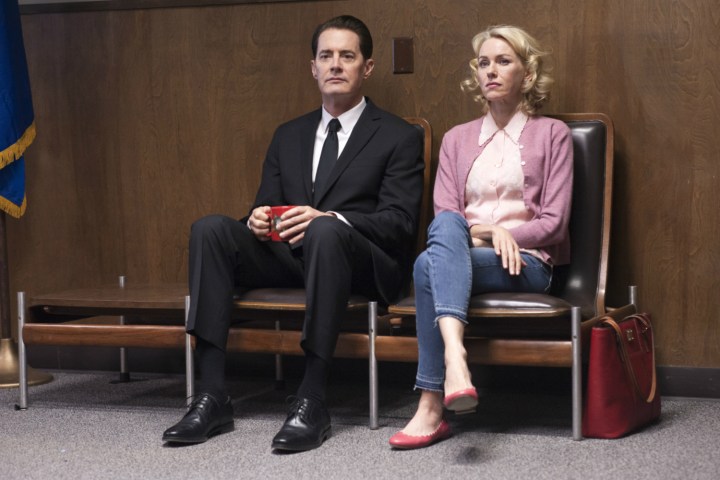
Halfway through Twin Peaks: The Return, where does everything stand? Agent Dale Cooper remains stranded in the life of Dougie Jones, insurance agent, though a return to his old self seems imminent. He survives an attack by hitman Ike “The Spike” Stadtler, whom he disarms — or dispalms — with the help of The Arm, by superheating Ike’s gun and burning off his flesh. As a result, Dougie draws the further attention of the three detectives, all with the last name Fusco, who suspect there is more to Dougie than his one-word answers and blank stare suggest. Heightening their suspicions is the fact that there are no records of Dougie before 1997; it’s as if he appeared out of thin air (or emerged from an electrical socket, as Cooper did in Part 3).
Detective D. Fusco (David Koechner), employing a classic police tactic, brings Dougie a fresh cup of coffee and steals away with the old one, which is covered in Dougie’s fingerprints and saliva, and sends it off to be tested. Unless something happens to the mug in transit, it seems likely that the search will get a hit for Agent Dale Cooper, alerting his former comrades at the FBI to his presence.

Speaking of the FBI crew, Gordon Cole, Albert Rosenfield, and Tammy Preston, over Diane’s protest, take a detour to Buckhorn, South Dakota, where the body of Major Garland Briggs lies waiting in the morgue. The murder of Garland Briggs, missing for 25 years, is one of the show’s more bizarre mysteries. His corpse resembles the body of a man in his 40s, despite the fact that he would be in his 70s, and if the testimony of the suspected killer, Bill Hastings (Matthew Lillard,) is to be believed, Briggs was hiding in another dimension. Hastings documented his — and his deceased lover Ruth’s — investigations into the other world on a blog, which is actually up and running.
The trip to Buckhorn turns up one more important piece of evidence: The ring the coroner found in Briggs’ body, engraved “To Dougie, with love, Janey-E.” The case is tied to the life of Dougie Jones, and along with the coffee mug, it seems likely to lead Cole and company to Cooper.
Back in Twin Peaks, the investigative trio of Sheriff Truman, Deputy Chief Hawk, and Bobby Briggs continue their own search for answers, talking to the major’s wife, Betty, who tells them that he foresaw them coming, and left a clue hidden in a chair. The clue is an unmarked cylinder, with no seams or openings, that Bobby knows how to open, throwing it to the ground until it produces the right frequency.
Inside is a message telling them to go to Jack Rabbit’s Palace, a place from Bobby’s youth, at a specific time two days from now. Another piece of paper shows a bunch of seemingly random numbers, and two instances of the word Cooper. As Hawk points out, “Two Coopers,” a reference to what they found in Laura Palmer’s diary. What the cops will find near Jack Rabbit’s Palace is a mystery, but they seem to be, like everyone else, on the road to Agent Cooper.

Regarding the Tale of Two Coopers, Part 9 returns to the doppelganger, bloodied from the attempt on his life in Part 8, who meets up with two accomplices, Hutch (Tim Roth) and Chantal (Jennifer Jason Leigh), who clean him up and provide him a truck. He makes a call to Duncan Todd (Patrick Fischler), asking if he finished the job, and all but confirming that the doppelganger put a hit on Dougie/Cooper.
It all comes back to Agent Cooper, the protagonist who has been essentially absent in the new episodes, wandering the Black Lodge as a confused spirit before climbing into the skin of Dougie Jones, sans memories. Many of the show’s threads, which seemed unrelated at first, are drawing together, and though the show is still fond of its diversions — Part 9 ends on two new characters hanging out at the Bang Bang Bar, talking about their jobs — it seems like something big is just around the bend.
Editors' Recommendations
- Wait, David Lynch directed a commercial for the Sony PlayStation?
- Steven Spielberg casts David Lynch in The Fabelmans


